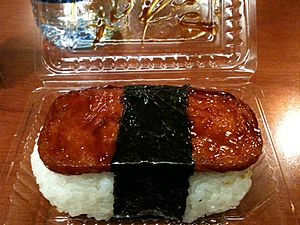Spam musubi facts for kids

Spam musubi made from Spam and rice
|
|
| Course | Snack |
|---|---|
| Place of origin | United States |
| Region or state | Hawaii |
| Serving temperature | Hot or cold |
| Main ingredients | Spam, rice, nori, soy sauce |
Spam musubi is a yummy snack and lunch food. It's made with a slice of grilled Spam, placed on or between a block of rice. All of this is wrapped up with nori, which is a type of dried seaweed. It's a bit like Japanese onigiri, which are rice balls.
You can find Spam musubi easily in places like Hawaii and Guam. They are cheap and easy to carry around, often sold in convenience stores. Making them at home is simple too! You usually just need Spam, rice, salt, nori (seaweed), and shoyu (soy sauce). Sometimes, famous chefs in Hawaii even serve fancy Spam musubi at special events.
History of Spam Musubi
The exact start of Spam musubi is not fully known. Some people who were in Japanese American internment camps in the United States say they made something similar first. They put seasoned Spam slices on white rice in a pan.
However, most stories about Spam musubi's origin focus on how popular Spam was in Hawaii during and after World War II. There weren't many other food choices then. So, canned Spam became a part of local meals wherever American soldiers were. For example, in South Korea, there's a stew called budae-jjigae that uses extra U.S. military foods, including Spam.
The Honolulu Star-Bulletin newspaper said in 2002 that there isn't a clear history for this food. But a cookbook from 2001 mentioned Mitsuko Kaneshiro as a possible creator. She started selling Spam musubi from a pharmacy in Honolulu. By the early 1980s, she was selling 500 handmade Spam musubi every day from her own shop, Michan's Musubi.
Another person said to be the creator is Barbara Funamura from Kauai. Funamura sold Spam musubi at the Joni-Hana restaurant. In 1983, a newspaper described it as "Spam and rice, two local favorites, are combined in an enormous musubi (rice ball) wrapped in nori." Funamura said, "That's the Spam musubi." Later, Funamura's musubi was made using a special box mold, which gave it its well-known shape.
How to Make Spam Musubi
Making Spam musubi usually starts with grilling or frying slices of Spam. Sometimes, a light teriyaki flavor is added. This flavor comes from a sauce often made with soy sauce and sugar.
You use a special mold that is the same size as a Spam slice. First, a layer of cooked rice is pressed down onto a strip of nori (seaweed). Then, a slice of Spam is placed on top of the rice. Sometimes, another layer of rice is added. After that, the mold is taken off. The nori is then wrapped over the top and around the musubi.
Spam musubi is often served with soy sauce or Japanese mayonnaise. In Guam, their local version is described as "a slice of Spam is bathed in teriyaki sauce before topping a mound of rice with a dash of furikake and wrapped in a strip of nori." Another recipe from Guam suggests using Sriracha mayonnaise for extra flavor.
See also
 In Spanish: Spam musubi para niños
In Spanish: Spam musubi para niños


